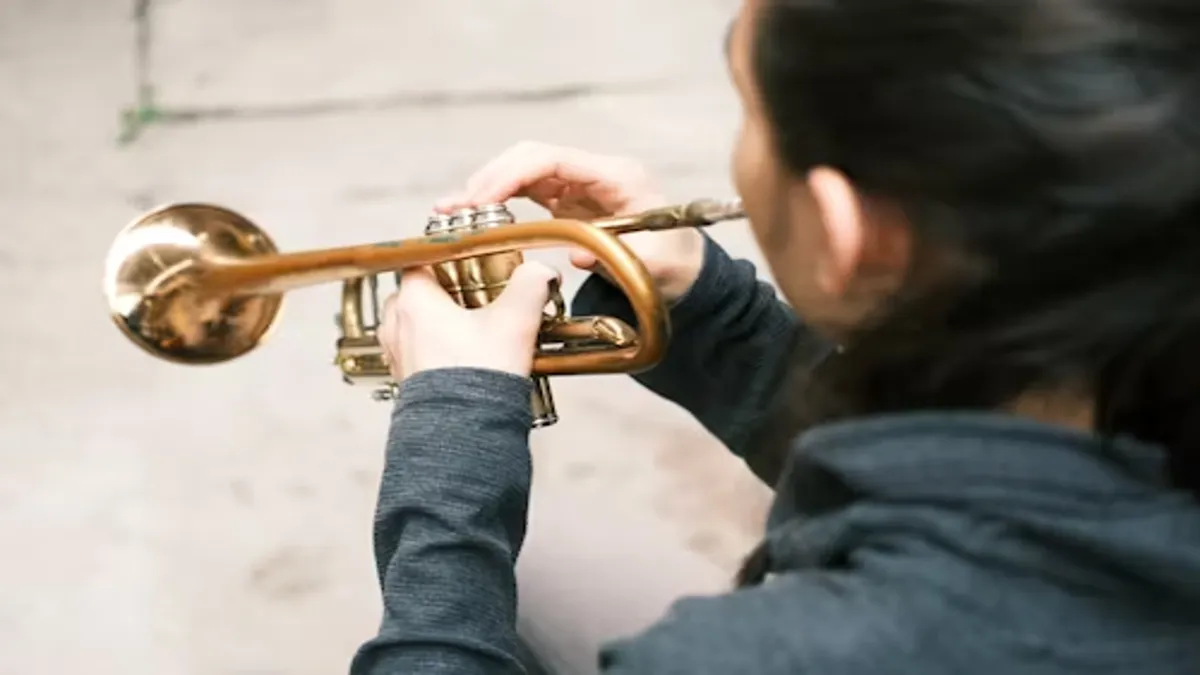Flugelhorn: The Warm Voice of Brass — History, Sound, and Legacy of Music’s Most Expressive Instrument
When people search for “flugelhorn,” they’re usually drawn by curiosity about its identity—what exactly it is, how it sounds, and why it’s adored by musicians across genres. Within the first hundred words, the answer is simple: the flugelhorn is a brass instrument resembling a trumpet but distinguished by its conical bore and deep, velvety tone. It’s the quiet storyteller of the brass family—gentle, expressive, and emotional. Its sound is softer than a trumpet yet richer than a cornet, ideal for jazz ballads, lyrical passages in orchestras, and moments when music calls for intimacy instead of brilliance. This article explores its origin, design, technique, famous performers, and its profound influence on modern soundscapes.
The flugelhorn is not a loud instrument—it’s a conversation starter. Unlike trumpets, which command attention, or trombones, which project authority, the flugelhorn whispers with warmth. For composers, it fills emotional gaps that neither strings nor horns can. For performers, it offers freedom to explore shades of tenderness rarely possible in brass.
The Birth of the Flugelhorn
The flugelhorn’s story begins in 19th-century Europe, born from military necessity rather than musical innovation. Its name derives from the German Flügelhorn—literally, “wing horn,” once used to signal the flanks (Flügel) of an army. Early versions were valveless bugles, simple instruments that carried melodies across open fields.
When valves were added in the mid-1800s, the flugelhorn evolved into a fully chromatic instrument capable of complex passages. It soon found its place in military bands, then brass bands, and eventually, orchestras. The wider tubing and rounded bell produced a sound less assertive than the trumpet’s. Instead, it emphasized warmth and lyricism—a tone suited to harmony rather than command.
“The flugelhorn is the human voice of brass,” wrote a 19th-century critic, “it sighs where the trumpet shouts.”
By the 20th century, its charm crossed the Atlantic, finding a second life in jazz and popular music.
Design and Structure: Why the Flugelhorn Sounds Unique
At first glance, the flugelhorn looks like a chubbier trumpet, but its internal geometry makes all the difference. Its tubing is more conical, meaning it widens gradually from mouthpiece to bell. This single detail softens its overtone structure, producing fewer high harmonics and creating its signature mellow timbre.
Read: Square-Central.com Trending News: The Digital Pulse of Global Conversations
Key Design Features
| Component | Description | Acoustic Effect |
|---|---|---|
| Bore Shape | Conical, not cylindrical | Warmer, darker tone |
| Bell Diameter | Larger and rounder than trumpet | Broader projection |
| Mouthpiece | Deep and V-shaped | Richer resonance |
| Leadpipe | Longer, gentler taper | Smooth airflow |
| Material | Brass or copper alloys | Adds color and warmth |
The flugelhorn’s valves work like a trumpet’s, but the air column behaves differently. The larger tubing means notes “speak” more slowly, encouraging a legato approach and discouraging harsh attacks.
“It’s like playing light through fog,” says one jazz musician. “Everything glows softly.”
Flugelhorn vs. Trumpet vs. Cornet
To the untrained ear, these instruments sound similar—but for musicians, each represents a distinct voice in the brass choir.
| Instrument | Bore Type | Sound Quality | Typical Use |
|---|---|---|---|
| Trumpet | Cylindrical | Bright, focused, and piercing | Orchestral, fanfare, lead jazz |
| Cornet | Slightly conical | Sweet, compact, lyrical | Brass band, early jazz |
| Flugelhorn | Deeply conical | Dark, mellow, and vocal | Jazz ballads, solo lines, film scores |
Where the trumpet leads, the flugelhorn accompanies; where the cornet blends, the flugelhorn soothes.
The Physics of Its Sound
A flugelhorn’s beauty lies in balance—its ability to resonate between boldness and softness. The conical bore filters the sharpness that defines the trumpet, while the deeper mouthpiece adds body. The result is a timbre often described as “chocolatey” or “velvet.”
Physically, its sound wave contains fewer upper harmonics, making it round and warm. This explains why microphones and recording studios love it—the tone records beautifully without harsh edges.
Sound engineers often position the flugelhorn near vocal microphones rather than brass ones. Its tone sits naturally between human speech and instrument resonance—a blend that feels emotionally immediate.
The Technique: A Different Mindset
For players transitioning from trumpet, the flugelhorn requires a new philosophy. Technically, it uses the same fingerings, but musically, it demands restraint and awareness.
Playing Approach
- Air Support: Softer yet sustained—think of exhaling warmth instead of power.
- Embouchure: Looser jaw, open throat, and deeper breath create the lush tone.
- Articulation: Tonguing is gentler; legato and slurs dominate phrasing.
- Vibrato: Controlled and subtle; the goal is intimacy, not decoration.
- Dynamic Range: Focuses on mid-volume expression; extremes can distort tone.
“You don’t play the flugelhorn,” said Art Farmer, “you let it speak through you.”
Technically forgiving but emotionally demanding, it challenges musicians to express with fewer notes, more breath, and more heart.
The Flugelhorn in Jazz: From Side Voice to Star
Jazz made the flugelhorn immortal. While classical music used it sparingly, jazz liberated it—giving it room to breathe and improvise.
Kenny Dorham and Art Farmer were among the first to champion the instrument in the 1950s. Their recordings proved the flugelhorn could carry melody with intimacy and authority. Chuck Mangione turned it into a pop-jazz symbol in the 1970s, introducing its mellow charm to radio listeners.
Modern players like Ingrid Jensen and Till Brönner have continued to evolve its voice, blending it into electronic, orchestral, and cinematic settings.
Key Jazz Contributions
| Artist | Contribution | Notable Work |
|---|---|---|
| Kenny Dorham | Pioneered lyrical tone in bebop | “Quiet Kenny” |
| Art Farmer | Defined the flugelhorn’s jazz identity | “Warm Valley” |
| Chuck Mangione | Popularized it in mainstream music | “Feels So Good” |
| Clark Terry | Balanced humor and precision | Big band recordings |
| Ingrid Jensen | Modern innovation and fusion | “At Sea” |
The flugelhorn became jazz’s confessional—its tone suited to introspection and nightclubs more than concert halls.
Classical and Contemporary Roles
In classical settings, composers use the flugelhorn to add color between trumpet and French horn. Gustav Mahler and Igor Stravinsky experimented with similar timbres, while modern composers write solo concertos that exploit its singing quality.
Film composers love the flugelhorn’s cinematic resonance. Its tone feels nostalgic without sounding sad, powerful without aggression. That’s why you hear it in romantic scores, reflective montages, and jazz-influenced soundtracks—it humanizes brass.
Learning and Practicing
Beginners often start with trumpet and shift to flugelhorn once fundamentals are strong. The following guidelines help bridge the transition smoothly:
- Practice long tones daily to explore resonance.
- Record yourself to hear tonal color changes.
- Alternate between trumpet and flugelhorn to balance embouchure strength.
- Focus on melodic etudes—it’s a lyrical instrument, not a technical showpiece.
- Listen deeply to recordings by Art Farmer and Kenny Dorham.
Students who learn on flugelhorn early often develop better phrasing and dynamic sensitivity—skills that transfer across all brass instruments.
Care and Maintenance
The flugelhorn’s warmth depends on its health. Because its tubing is wider and more delicate, it demands careful maintenance.
Basic Care Routine
- Oil valves regularly to ensure smooth motion.
- Clean the mouthpiece weekly to prevent buildup.
- Rinse internal tubing with lukewarm water every month.
- Avoid dents—minor damage can disrupt airflow and ruin intonation.
- Store in a cushioned case; its bell is especially vulnerable.
“A clean horn plays like it remembers you,” says one technician. “A neglected one forgets.”
Choosing the Right Flugelhorn
There’s no universal “best” model—each suits a particular sound preference.
| Brand | Tone Quality | Notable Feature |
|---|---|---|
| Yamaha | Balanced, reliable | Smooth valve action |
| Bach | Warm and orchestral | Deep resonance |
| Adams | Customizable designs | Excellent projection |
| Kanstul | Vintage American tone | Flexible response |
| Schagerl | European brilliance | Precise intonation |
When buying, focus less on brand and more on feel. Does it respond easily? Does it sing when played softly? Those are the questions that matter.
Common Misconceptions
- It’s just a softer trumpet.
False—the physics and mouthpiece make it an entirely different sound concept. - It’s easy to play.
It’s forgiving on the lips but demanding in tone control and pitch. - It only works for slow songs.
While ideal for ballads, modern jazz and funk use it dynamically. - It can replace a trumpet.
Never fully—the flugelhorn’s voice complements rather than substitutes. - It’s outdated.
On the contrary, it’s enjoying a renaissance through cinematic and hybrid genres.
The Emotional Vocabulary of the Flugelhorn
The flugelhorn communicates mood like few other instruments. Its timbre suggests human emotion—melancholy, tenderness, nostalgia. In the right hands, it can sound like a whisper or a prayer.
“The flugelhorn doesn’t perform,” said one composer. “It remembers.”
Whether it’s played on a dimly lit stage or within a symphony’s texture, the instrument draws the listener inward. Its value lies not in volume but in vulnerability.
Modern Innovations and Future Possibilities
Today’s makers are pushing boundaries—experimenting with carbon fiber, hybrid bells, and digital modifications. Flugelhorns are being paired with effects pedals, loop stations, and ambient reverb for experimental performances.
Some producers use sampled flugelhorns in electronic tracks, combining analog breath with digital texture. This evolution shows that even an old-world instrument can thrive in futuristic settings.
“Technology didn’t replace warmth,” says a modern arranger. “It just gave warmth new space.”
The Flugelhorn as a Metaphor
Beyond its musical life, the flugelhorn symbolizes restraint—a reminder that power need not be loud. Its philosophy fits our moment: connection over noise, tone over speed.
It represents artistry at its most human—where control meets vulnerability, and sound becomes storytelling.
Conclusion: The Intimate Power of Sound
The flugelhorn remains one of music’s most poetic inventions. It invites the listener closer, turning performance into conversation. In an era where loudness dominates, its quiet authority feels revolutionary. From 19th-century battlefields to 21st-century studios, the flugelhorn has traveled across time and genre, carrying with it one enduring truth: beauty doesn’t need to shout to be heard.
Its legacy continues in jazz clubs, orchestras, classrooms, and soundtracks, reminding every musician that tone is not only a matter of technique but of empathy. The flugelhorn’s song endures because it sounds like the heart itself—steady, soft, and sincere.
FAQs
1. What is a flugelhorn?
A brass instrument resembling a trumpet but with a conical bore, producing a warm, mellow tone used in jazz and classical music.
2. How does the flugelhorn differ from a trumpet?
The flugelhorn’s conical tubing and deeper mouthpiece give it a darker, rounder sound, while the trumpet is brighter and sharper.
3. Who are the most famous flugelhorn players?
Kenny Dorham, Art Farmer, Chuck Mangione, and Ingrid Jensen are among the most influential flugelhornists in modern music.
4. Is the flugelhorn suitable for beginners?
It’s easier to learn after mastering trumpet fundamentals, but its soft tone makes it rewarding for intermediate players.
5. What genres use the flugelhorn today?
It appears in jazz, pop, film scores, orchestral compositions, and even ambient electronic music for its expressive warmth.







